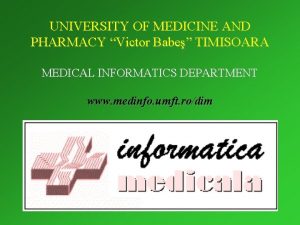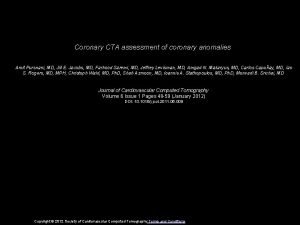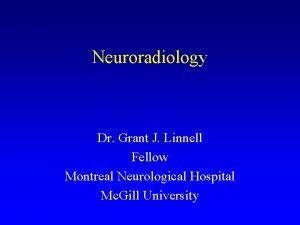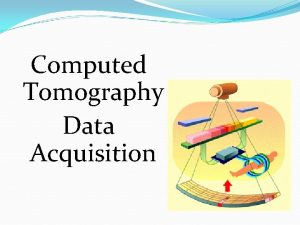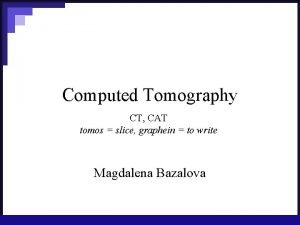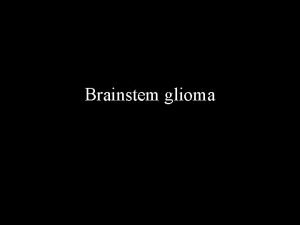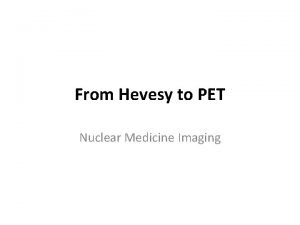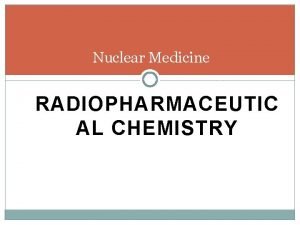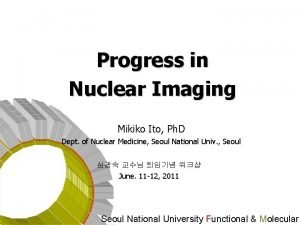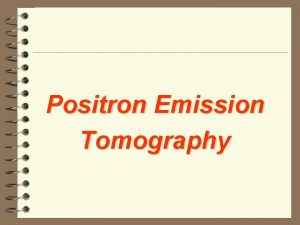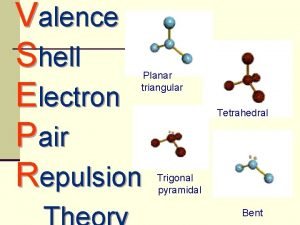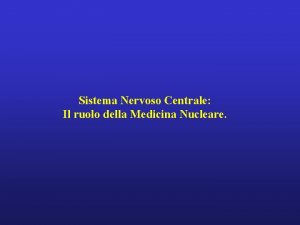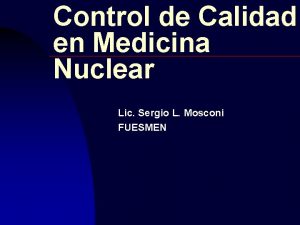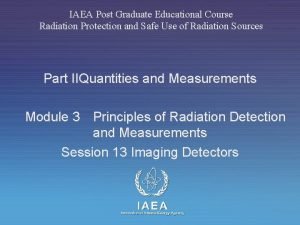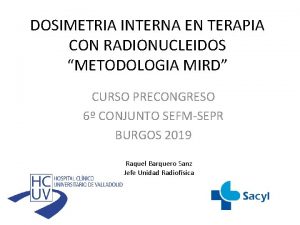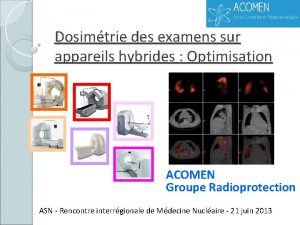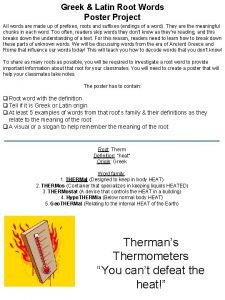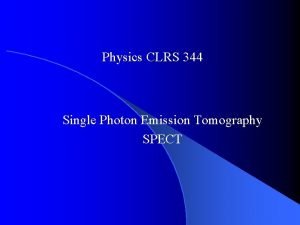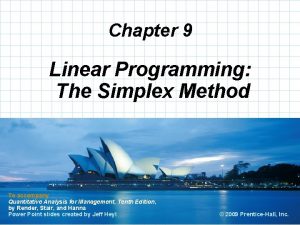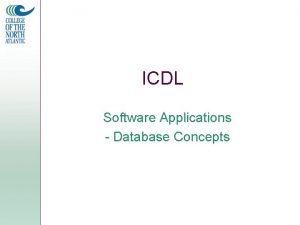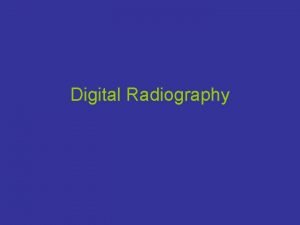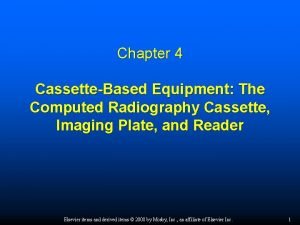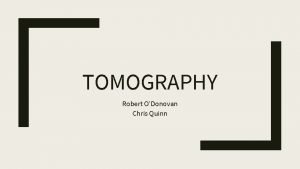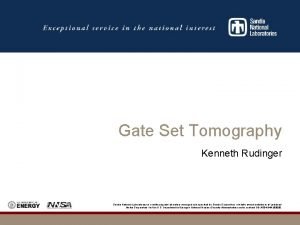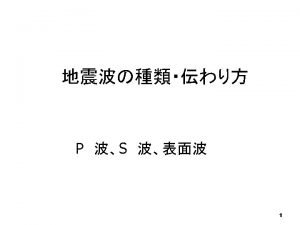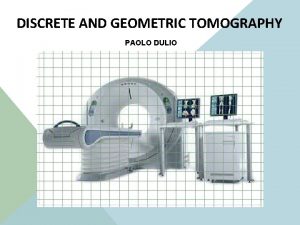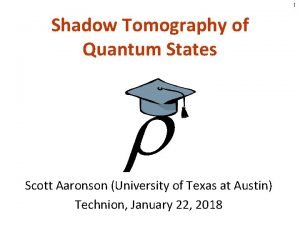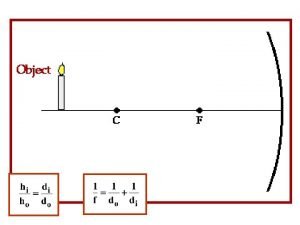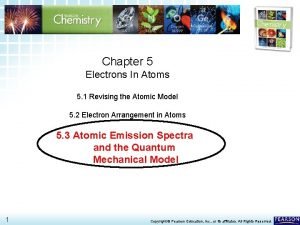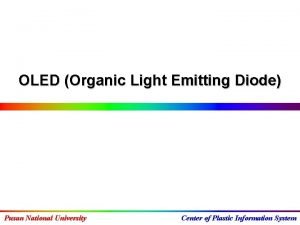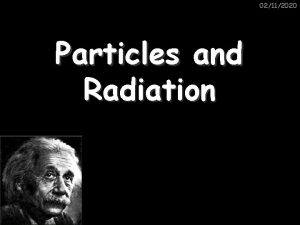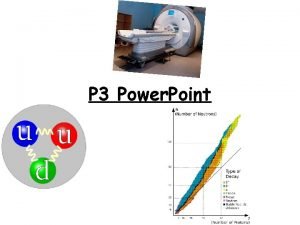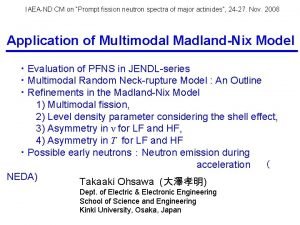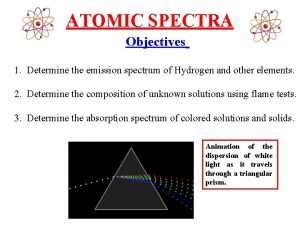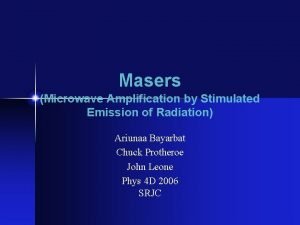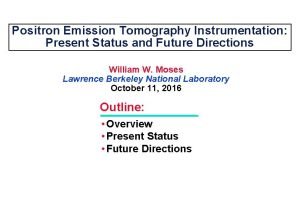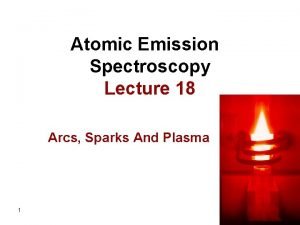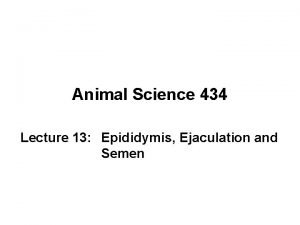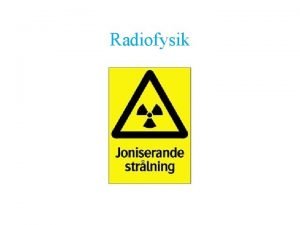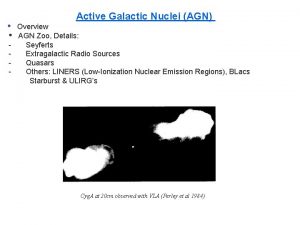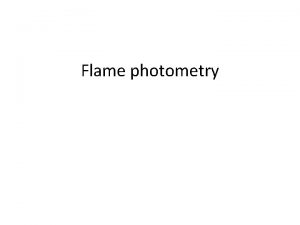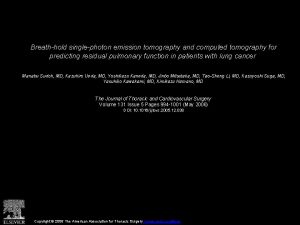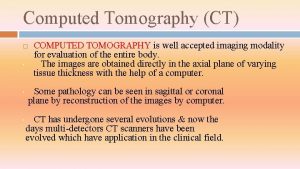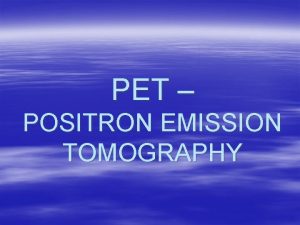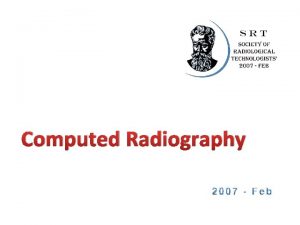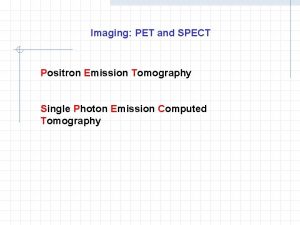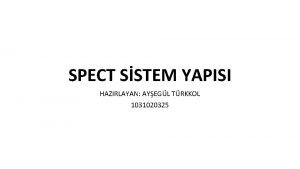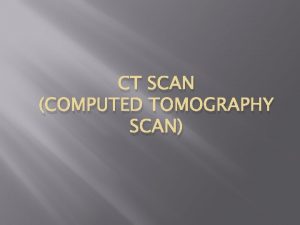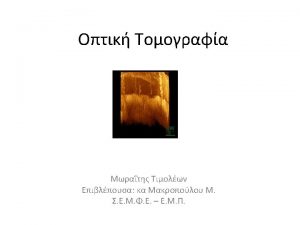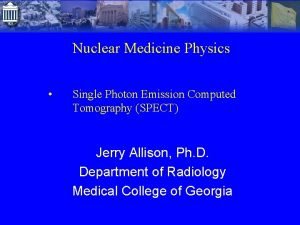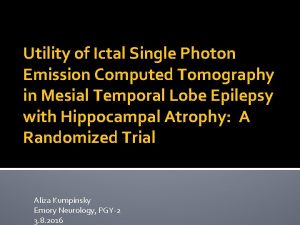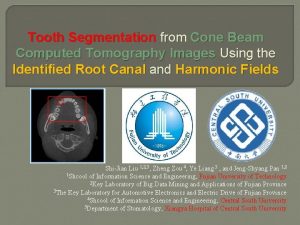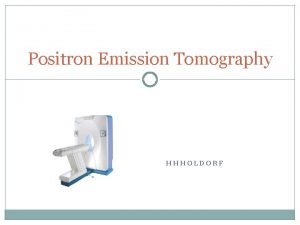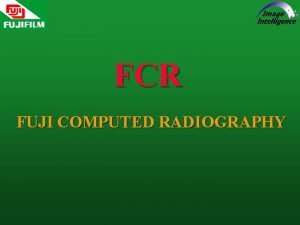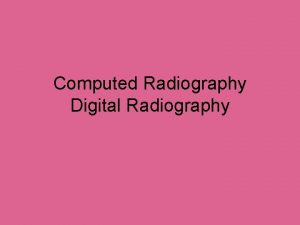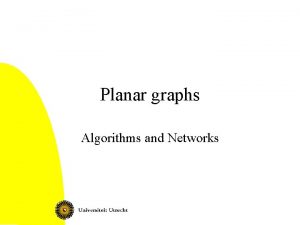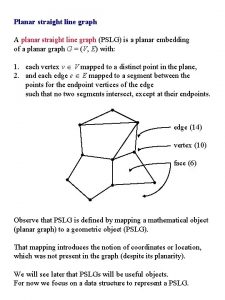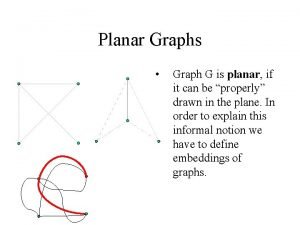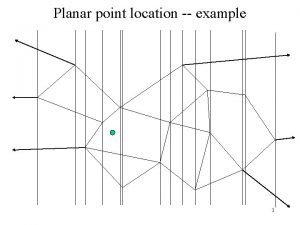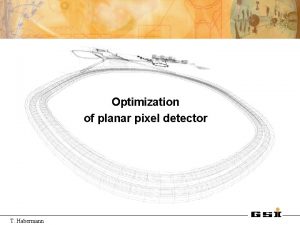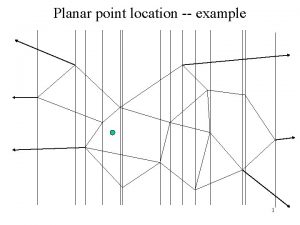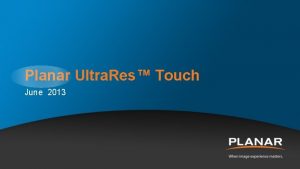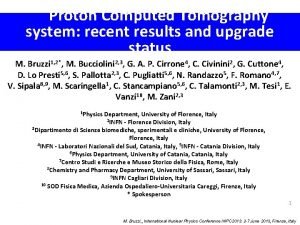Chapter4 SinglePhoton emission computed tomography SPECT Planar images



















































- Slides: 51

Chapter-4 Single-Photon emission computed tomography (SPECT) Planar images (2 D) Vs. Single-Photon emission computed tomography (SPECT)(3 D) Advantages of tomographic images • • A basic problem in conventional radionuclide imaging is that the images obtained are 2 D projections of 3 D source distributions. Images of structures at one depth in the patient thus are obscured by superimposed images of overlying and underlying structures. One solution is to obtain tomographic imaging (3 D images= multiple 2 D slices of a 3 D object). Tomographic images are capable of providing more accurate quantitation of activity at specific locations within the body

Chapter-4 Single-Photon emission computed tomography (SPECT) Tomographic images • • Tomos is Greek word for cut or section Modern computed tomography (CT) techniques, including positron emission tomography (PET) and single photon emission tomography (SPECT), and x-ray CT, use detector systems rotated around the object so that many different angular views (known as projections) of the object are obtained. Mathematical algorithms then are used to reconstruct images of selected planes within the object from these projection data. Reconstruction of images from multiple projections of the detected emission from radionuclides within the body is known as emission computed tomography (ECT)

Chapter-4 Single-Photon emission computed tomography (SPECT) Tomographic images (SPECT camera)

Chapter-4 Single-Photon emission computed tomography (SPECT) • • SPECT cameras acquire multiple planar views of the radioactivity in an organ. The sequential planar views acquired during tomographic acquisition are called Projection views The data are then processed mathematically to create cross-sectional views of the organ SPECT utilizes the single photons emitted by gamma-emitting radionuclides such as 99 m. Tc, 67 Ga, 111 In and 123 I. This is in contrast to positron emission tomography (PET), which utilizes the paired 511 -Ke. V photons arising from positron annihilation.

Chapter-4 Single-Photon emission computed tomography (SPECT) Types of cameras • • • The simplest camera design for SPECT imaging is similar to that of a planar camera but with two additional features First; the SPECT camera is constructed so that the head can rotate either stepwise or continuously about the patient to acquire multiple views. Second; it is equipped with a computer that integrates the multiple images to produce the cross-sectional views of the organ

Chapter-4 Single-Photon emission computed tomography (SPECT) Types of cameras • • • The more advanced SPECT camera designs have more than one head or are constructed with a ring of detectors. In the case of the single and multiple head cameras, the heads are mechanically rotated around the patient to obtain the multiple projections views. Ring detectors have a ring of individual small crystals or a single, donut-shaped crystal that does not rotate.

Chapter-4 Single-Photon emission computed tomography (SPECT) Types of cameras

Chapter-4 Single-Photon emission computed tomography (SPECT) Angle of rotation • • Single-headed cameras must rotate a full 360 degree to obtain all necessary views of most organs. in contrast, each head of a doubleheaded camera need rotate only half as far, 180 degree, and a tripleheaded camera only 120 degree to obtain the same views. The cost of the additional heads must be balanced against the benefits of increased speed of acquisition.

Chapter-4 Single-Photon emission computed tomography (SPECT) Angle of rotation

Chapter-4 Single-Photon emission computed tomography (SPECT) Arc acquisition • • Tomographic projection views are most often acquired over an arc of 360 or 180 degree. The 360 arc of rotation of the camera heads is regularly used for most organs. The 180 degree arc is used for organs that are positioned on one side of the body, such as the heart. Views of the heart are obtained in a 180 degree arc extending from the right anterior oblique position to the left posterior oblique position.

Chapter-4 Single-Photon emission computed tomography (SPECT) Equipment Arc acquisition The data from this 180 degree is considered adequate

Chapter-4 Single-Photon emission computed tomography (SPECT) Equipment Number of projection tomographic views Over a full 360 degree arc, 64 or 128 tomographic projections are usually collected; similarly 32 or 64 views are generally obtained over a 180 degree arc.

Chapter-4 Single-Photon emission computed tomography (SPECT) Collection times for a given dose of radiopharmaceutical, better images are generated using the higher count statistics from longer acquisitions. However, patient comfort and cooperation limit imaging times. Acquisition times of 20 to 40 seconds per projection views are standard.

Chapter-4 Single-Photon emission computed tomography (SPECT) Collection methods Steps-and-shoots vs. continuous acquisition • One method for collection of tomographic projection views is called step-and-shoot acquisition. • In this technique, each projection view is acquired in entirely at each angular stop (position). There is a short pause of a few seconds between views to allow for the automatic rotation of the camera head to the next stop. The camera makes a single rotation around the patient.

Chapter-4 Single-Photon emission computed tomography (SPECT) Collection methods Steps-and-shoots vs. continuous acquisition • In continuous acquisition, data are collected over one or several sequential 360 degree rotations. There are no pause; rotation is continuous.

Chapter-4 Single-Photon emission computed tomography (SPECT) Collection methods Steps-and-shoots vs. continuous acquisition

Chapter-4 Single-Photon emission computed tomography (SPECT) Collection methods Steps-and-shoots vs. continuous acquisition

Chapter-4 Single-Photon emission computed tomography (SPECT) Collection methods Circular Vs. Elliptical orbits • Most acquisitions are performed with a circular orbit. The camera head is rotated at a fixed distance from the center of the body. Since the body is more nearly elliptical than circular in cross section, the camera does not come as close to the organ as possible over a significant portion of its rotation. Because image resolution is better if the camera is as close to an organ as possible, some cameras are designed to rotate in elliptical orbits, which allow the camera head to more closely follow the contour of the body and therefore stay closer to the organ being imaged)

Chapter-4 Single-Photon emission computed tomography (SPECT) Collection methods Circular Vs. Elliptical orbits

Chapter-4 Single-Photon emission computed tomography (SPECT) Vidoes (SPECT) https: //www. youtube. com/watch? v=7 BEq. UGFDqw. M https: //www. youtube. com/watch? v=nqnr. O 6 x 45 SQ (heart) https: //www. youtube. com/watch? v=l 6 V 6 VLx. Qlk. Y (QA) https: //vimeo. com/88175239

Chapter-4 Single-Photon emission computed tomography (SPECT)

Chapter-4 Single-Photon emission computed tomography (SPECT) Reconstruction • Reconstruction is the process of creating trans-axial slices from projection views. • There are two basic approaches to creating the trans-axial slices. 1. Filtered backprojection 2. Iterative reconstruction

Chapter-4 Single-Photon emission computed tomography (SPECT) Reconstruction

Chapter-4 Single-Photon emission computed tomography (SPECT) Reconstruction

Chapter-4 Single-Photon emission computed tomography (SPECT) Reconstruction

Chapter-4 Single-Photon emission computed tomography (SPECT) Reconstruction

Chapter-4 Single-Photon emission computed tomography (SPECT) Reconstruction

Chapter-4 Single-Photon emission computed tomography (SPECT) Reconstruction Sinogram • For the purpose of analysis, it is convenient to introduce a new coordinate system that is stationary with respect to the gamma camera detector. • This is denoted as the (r, �� ) coordinate system a representation of this matrix, generically known as a sinogram • Each row across the matrix represents an intensity display across a single projection. • The successive rows from top to bottom represent successive projection angles.

Chapter-4 Single-Photon emission computed tomography (SPECT) Reconstruction Sinogram

Chapter-4 Single-Photon emission computed tomography (SPECT) Reconstruction Sinogram

Chapter-4 Single-Photon emission computed tomography (SPECT) Reconstruction Sinogram

Chapter-4 Single-Photon emission computed tomography (SPECT) Reconstruction Sinogram • The sinogram provides a convenient way to represent the full set of data acquired during a scan and can be useful for determining the causes of artifacts in SPECT and PET

Chapter-4 Single-Photon emission computed tomography (SPECT) Reconstruction Sinogram is useful to study motion artifacts

Chapter-4 Single-Photon emission computed tomography (SPECT) Reconstruction Simple and Filtered back projection • The general goal of reconstruction tomography is to generate a 2 D crosssectional image of activity from a slice within the object, using the projection profiles obtained for that slice. • The most basic approach for reconstructing an image from the profiles is by simple backprojection

Chapter-4 Single-Photon emission computed tomography (SPECT) Reconstruction

Chapter-4 Single-Photon emission computed tomography (SPECT) Reconstruction (Simple and Filtered back projection) • The concepts are illustrated for a point source object • Projections profiles are acquired from different angles around the source • Approximation for the source distribution within the plane is obtained by projecting (or distributing) the data from each element in a profile back across the entire image grid

Chapter-4 Single-Photon emission computed tomography (SPECT) Reconstruction (Simple and Filtered back projection) • The counts recorded in a particular projection profile element are divided uniformly amongst the pixels that fall within its projection path (this operation is called backprojection) • When the backprojections for all profiles are added together, an approximation of the distribution of radioactivity within the scanned slice is obtained

Chapter-4 Single-Photon emission computed tomography (SPECT) Reconstruction (Simple and Filtered back projection) • Projecting the data back toward the center that gives the term backprojection

Chapter-4 Single-Photon emission computed tomography (SPECT) Reconstruction (Simple and Filtered back projection) • This figure is a representation of data obtained in the acquisition of the projection views of a thin radioactive disk. • In this figure, an imaginary grid is placed over the disk (A). The disk is imaged (B), and the counts for each pixel are recorded (C) [ideally]

Chapter-4 Single-Photon emission computed tomography (SPECT) Reconstruction (Simple and Filtered back projection) • The counts in each of the cells of a column are summed and stored in an array (D) [during collection]. • In a similar manner, all of the rows are summed and stored in an array of sums to the right of the matrix (E ) [during collection].

Chapter-4 Single-Photon emission computed tomography (SPECT) Reconstruction (Simple and Filtered back projection) • During the backprojection, the two arrays of projection data are used to recreate the original disk. • The upper array is spread or backprojected across the columns of a blank matrix so that each of the values in any single column are identical.

Chapter-4 Single-Photon emission computed tomography (SPECT) Reconstruction (Simple and Filtered back projection) • The array to the right of the matrix is backprojected across the rows, and these values are added cell by cell to the values of the preceding set

Chapter-4 Single-Photon emission computed tomography (SPECT) Reconstruction (Simple and Filtered back projection) • If the counts in each pixel are represented by dots (for ease of illustration each dot represents 5 counts) one begins to see a relatively dense central area that corresponds generally to the size and the location of the original disk

Chapter-4 Single-Photon emission computed tomography (SPECT) Reconstruction (Simple and Filtered back projection) • The wide bans of dots extending in four directions from this central density are an artifact of the backprojection process; they are residual counts from the backprojection of the arrays.

Chapter-4 Single-Photon emission computed tomography (SPECT) Reconstruction (Simple and Filtered back projection) • The image built up by a simple backprojection resembles the true source distribution. • However, there is an obvious artifact in that counts inevitably are projected outside the true location of the object, resulting in a blurring of its image.

Chapter-4 Single-Photon emission computed tomography (SPECT) Reconstruction (Simple and Filtered back projection) • A type of noise peculiar to the reconstruction process is called star artifact, so named because a star composed of the backprojection “rays” surround each object (A) • The quality of the image can be improved and the star artifact can be reduced by increasing the number of projection angles and the number of samples along the profile. • The star artifact can also be reduced by a mathematical technique called “filtering”

Chapter-4 Single-Photon emission computed tomography (SPECT) Signal vs. Noise • The signal is that part of the information that produces the actual image. • Noise is extraneous data and may have no direct relation to the actual image. • Noise reduces the quality of the image. • Photon scattering, statistical variation, and random electronic fluctuation are among the sources of noise, which can be reduced by improved collimation, longer acquisition times and better design of the circuitry.

Chapter-4 Single-Photon emission computed tomography (SPECT) Reconstruction (Simple and Filtered back projection) Filtering • Filtering is a mathematical technique applied during reconstruction to improve the appearance of the image. • Filters have different types • Two types of filter s will be discussed • Filters used to reduce the effects of the star artifact • Filters used to remove noise due to photon scattering and statistical variations in counts

Chapter-4 Single-Photon emission computed tomography (SPECT) Reconstruction (Simple and Filtered back projection) Filtering Domain of Images Spatial domain • When image data is represented in counts per pixel, this data is said to be in spatial domain • Filtering proves to be computationally burdensome Frequency domain • This is when the data is represented as a series of sine waves. • The data is said to be transformed into the frequency domain • It is easier to perform filtering in this domain

Chapter-4 Single-Photon emission computed tomography (SPECT) Reconstruction (Simple and Filtered back projection) Filtering Spatial and Frequency domains of Images • These two domains are not entirely independent. • In fact, they only represent different views of the underlying data

Chapter-4 Single-Photon emission computed tomography (SPECT) Vidoes • • FBP (https: //www. youtube. com/watch? v=dd. Ze. LNh 9 aac) FBP (https: //www. youtube. com/watch? v=8 V 2 QBD 8 nh_s) • Reconstruction (https: //www. youtube. com/watch? v=MTBhqc. Vj. Q 8 Q) • FBP (https: //www. youtube. com/watch? v=Zt. Rs. VPXrm. Sc)
 Magnetic resonance timisoara
Magnetic resonance timisoara Journal of cardiovascular computed tomography
Journal of cardiovascular computed tomography Hematome
Hematome Data acquisition in ct
Data acquisition in ct Computed tomography artifacts
Computed tomography artifacts Computed tomography
Computed tomography Positron emission tomography
Positron emission tomography Positron emission tomography
Positron emission tomography Positron emission tomography
Positron emission tomography Positron emission tomography
Positron emission tomography Positron emission tomography
Positron emission tomography Tetrahedral vs trigonal planar
Tetrahedral vs trigonal planar Slidetodoc.com
Slidetodoc.com Nnnn nvclear
Nnnn nvclear Spect prefix words
Spect prefix words Spect
Spect Spect
Spect Appareil hybride spect/ct
Appareil hybride spect/ct Greek and latin roots poster
Greek and latin roots poster Spect
Spect The zj row in a simplex table for maximization represents
The zj row in a simplex table for maximization represents A computed is a calculation that a dbms performs
A computed is a calculation that a dbms performs Contribution margin per unit
Contribution margin per unit Sulphonal casset
Sulphonal casset Radiography cassette
Radiography cassette A tracking signal is computed by
A tracking signal is computed by Seismic tomography ______.
Seismic tomography ______. What is tomography
What is tomography Kenneth rudinger
Kenneth rudinger Seismic tomography
Seismic tomography Tomography
Tomography Shadow tomography
Shadow tomography Https://tw.images.search.yahoo.com/images/view
Https://tw.images.search.yahoo.com/images/view How to save images on google images
How to save images on google images Real vs virtual image
Real vs virtual image Https://tw.images.search.yahoo.com/images/view
Https://tw.images.search.yahoo.com/images/view Real images vs virtual images
Real images vs virtual images Atomic emission spectra and the quantum mechanical model
Atomic emission spectra and the quantum mechanical model Oled
Oled Lepton number
Lepton number Aplha decay
Aplha decay Neutron emission
Neutron emission Beilstein test
Beilstein test Emission
Emission Microwave amplification by stimulated emission of radiation
Microwave amplification by stimulated emission of radiation Positron emission
Positron emission Atomic emission spectroscopy lecture notes
Atomic emission spectroscopy lecture notes Emission vs ejaculation
Emission vs ejaculation Alfa beta gamma strålning
Alfa beta gamma strålning Miller zoo emission
Miller zoo emission Flame spectroscopy principle
Flame spectroscopy principle Absortpion
Absortpion
